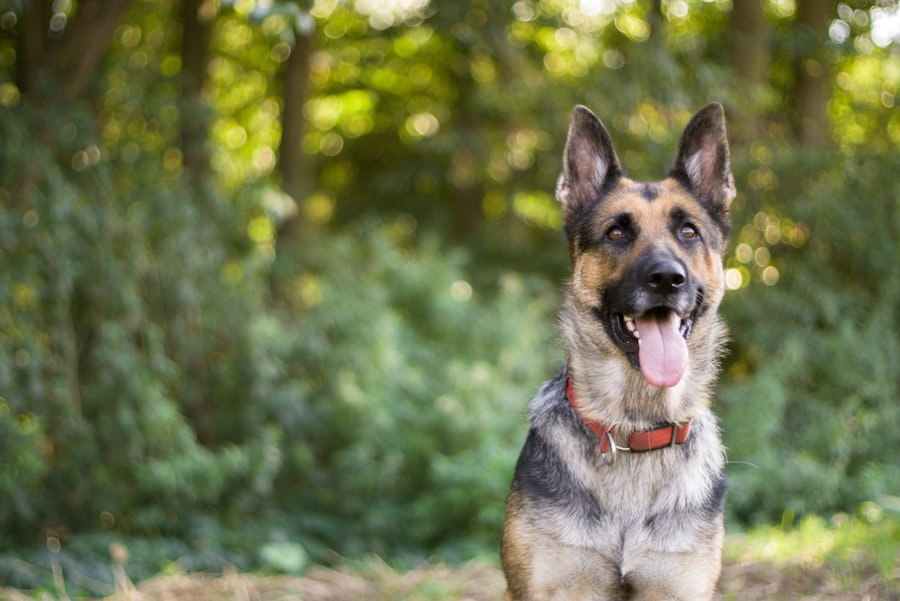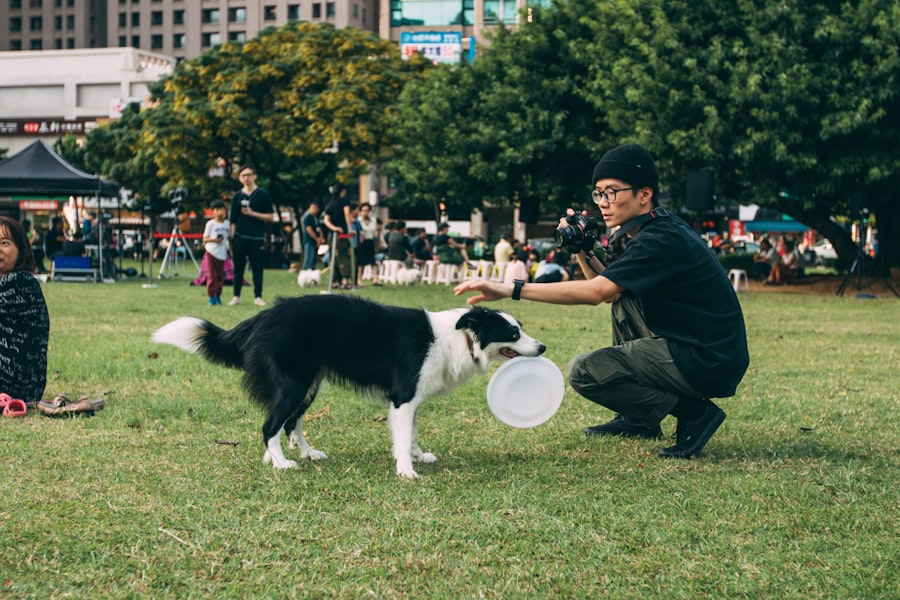To effectively train your dog, it is crucial to first understand their behavior. Dogs communicate primarily through body language, vocalizations, and actions. By observing your dog closely, you can gain insights into their feelings and needs.
For instance, a wagging tail often indicates excitement or happiness, while a tucked tail may suggest fear or submission. Recognizing these signals allows you to respond appropriately, fostering a stronger bond between you and your furry friend. Moreover, understanding the reasons behind certain behaviors can help you address unwanted actions more effectively.
For example, if your dog barks excessively when someone approaches the door, it may be a sign of territorial instinct or anxiety. By identifying the root cause of such behaviors, you can tailor your training approach to meet your dog’s specific needs. This understanding not only aids in correcting undesirable behaviors but also enhances your overall relationship with your pet.
Key Takeaways
- Understanding your dog’s behavior is crucial for effective training and communication.
- Establishing leadership and boundaries helps your dog understand their role in the family pack.
- Using positive reinforcement, such as treats and praise, can encourage good behavior in your dog.
- Consistency in training is key to reinforcing desired behaviors and preventing confusion.
- Patience and persistence are essential for successful dog training and behavior modification.
- Socialization and exposure to different environments and situations are important for a well-rounded and confident dog.
- Training for specific commands, such as sit, stay, and come, can improve communication and safety.
- Seeking professional help from a certified dog trainer or behaviorist is recommended for complex issues or if you’re struggling with training.
Establishing Leadership and Boundaries
Establishing yourself as a leader in your dog’s life is essential for effective training. Dogs are pack animals by nature, and they thrive in environments where they understand their place within the hierarchy. By demonstrating calm assertiveness, you can instill confidence in your dog and help them feel secure in their role within your household.
This does not mean being harsh or domineering; rather, it involves setting clear expectations and consistently enforcing them. Boundaries are equally important in creating a harmonious living environment. Dogs need to know what is acceptable behavior and what is not.
For instance, if you want your dog to stay off the furniture, it is vital to enforce this rule consistently. If you allow them on the couch sometimes but not others, it can lead to confusion and frustration for both of you. By establishing clear boundaries and sticking to them, you help your dog understand their limits, which ultimately leads to better behavior.
Using Positive Reinforcement

Positive reinforcement is one of the most effective training methods available to dog owners. This approach involves rewarding your dog for desired behaviors rather than punishing them for unwanted ones. When you use treats, praise, or playtime as rewards, you create a positive association with the behavior you want to encourage.
For example, if your dog sits on command and you reward them immediately with a treat, they are more likely to repeat that behavior in the future. Incorporating positive reinforcement into your training routine not only helps with obedience but also strengthens the bond between you and your dog. When your dog sees that good behavior leads to rewards, they become more motivated to please you.
This method fosters trust and encourages a willingness to learn, making training sessions enjoyable for both of you. Remember that consistency is key; rewarding your dog every time they exhibit the desired behavior will reinforce their learning.
Consistency in Training
| Training Metric | Value |
|---|---|
| Number of Training Sessions | 20 |
| Training Duration | 60 minutes |
| Training Frequency | 3 times per week |
| Consistency Rating | 8 out of 10 |
Consistency is a cornerstone of effective dog training. Dogs thrive on routine and predictability, so it is essential to maintain a steady approach in your training efforts. This means using the same commands for specific actions and ensuring that all family members are on the same page regarding training techniques.
If one person allows certain behaviors while another enforces rules, it can lead to confusion for your dog and hinder their progress. Additionally, consistency extends beyond verbal commands; it also includes your tone of voice and body language. If you use a stern tone when giving commands but a playful tone when rewarding good behavior, your dog may struggle to understand what you expect from them.
By maintaining a consistent approach in all aspects of training, you create a clear framework for your dog to follow, which ultimately leads to more effective learning.
Patience and Persistence
Training a dog requires both patience and persistence. It is important to remember that every dog learns at their own pace, and some may take longer than others to grasp certain commands or behaviors. Frustration can arise when progress seems slow, but it is crucial to remain patient and understanding.
Celebrate small victories along the way, as these incremental improvements are signs of progress. Persistence is equally important in the training process. There will be times when your dog may seem disinterested or resistant to learning new commands.
During these moments, it is essential to stay committed to your training goals and continue working with your dog. Regular practice sessions, even if they are short, can help reinforce learning and keep your dog engaged. Remember that consistency combined with patience will yield positive results over time.
Socialization and Exposure

Socialization plays a vital role in shaping your dog’s behavior and temperament. Exposing your dog to various environments, people, and other animals helps them develop confidence and adaptability. Early socialization is particularly important for puppies, as it lays the foundation for their future interactions.
Take the time to introduce your puppy to different sights, sounds, and experiences in a controlled manner to ensure they grow into well-adjusted adults. As your dog matures, continue to provide opportunities for socialization. Regular trips to parks, dog-friendly events, or even playdates with other dogs can help reinforce positive behaviors and reduce anxiety in new situations.
A well-socialized dog is less likely to exhibit fear-based behaviors or aggression towards unfamiliar stimuli. By prioritizing socialization throughout your dog’s life, you contribute significantly to their overall well-being.
Training for Specific Commands
Training your dog for specific commands is an essential aspect of responsible pet ownership. Commands such as “sit,” “stay,” “come,” and “leave it” can enhance safety and improve communication between you and your dog. Start with basic commands that are easy for your dog to understand and gradually progress to more complex ones as they become more comfortable with training.
When teaching specific commands, use clear verbal cues along with hand signals if possible. This dual approach can help reinforce learning by providing visual cues alongside auditory ones. Be sure to practice these commands in various environments to ensure that your dog can respond reliably regardless of distractions.
Consistent practice will help solidify these commands in your dog’s mind, making them more responsive in real-life situations.
Seeking Professional Help when Necessary
While many dog owners can successfully train their pets on their own, there are times when seeking professional help may be necessary. If you encounter persistent behavioral issues or find yourself overwhelmed by the training process, consulting a professional dog trainer or behaviorist can provide valuable guidance. These experts have the experience and knowledge needed to address specific challenges and develop tailored training plans.
Professional trainers can also offer insights into advanced techniques that may not be readily available through self-study. They can assess your dog’s behavior in real-time and provide immediate feedback on how to improve your training methods. Remember that seeking help is not a sign of failure; rather, it demonstrates a commitment to providing the best possible care for your furry companion.
In conclusion, understanding your dog’s behavior, establishing leadership and boundaries, using positive reinforcement, maintaining consistency in training, exercising patience and persistence, prioritizing socialization, teaching specific commands, and knowing when to seek professional help are all integral components of successful dog training. By embracing these principles, you can foster a strong bond with your dog while ensuring they grow into a well-behaved and happy member of your family.
If you are looking to take your dog camping, you may want to check out this article on camping tips for dogs. It provides helpful advice on how to make the most of your outdoor adventure with your furry friend. Additionally, if you are concerned about how cold weather may affect your dog, you can read this article on how cold can dogs handle to learn more about keeping your pup safe and comfortable in chilly temperatures.
FAQs
What is dog training?
Dog training is the process of teaching a dog to exhibit certain behaviors in response to specific commands or cues. This can include obedience training, behavior modification, and teaching specific skills or tricks.
Why is dog training important?
Dog training is important for several reasons. It helps to establish a bond between the dog and its owner, improves communication, and enhances the dog’s overall behavior and obedience. Training also helps to ensure the safety of the dog and those around it.
What are the different methods of dog training?
There are various methods of dog training, including positive reinforcement, clicker training, dominance-based training, and electronic collar training. Positive reinforcement, which involves rewarding desired behaviors, is widely considered to be the most effective and humane approach.
When should I start training my dog?
It is best to start training your dog as early as possible, ideally when they are still a puppy. Early training helps to establish good habits and prevent behavior problems from developing.
Can I train my dog myself, or should I hire a professional trainer?
Many dog owners are able to successfully train their dogs on their own, especially with the help of resources such as books, videos, and online tutorials. However, some owners may benefit from working with a professional trainer, especially if their dog has specific behavior issues or training needs.
How long does it take to train a dog?
The time it takes to train a dog can vary depending on the individual dog, the training methods used, and the specific behaviors or skills being taught. Some basic obedience training can be accomplished in a few weeks, while more advanced training may take several months. Consistency and patience are key to successful dog training.
